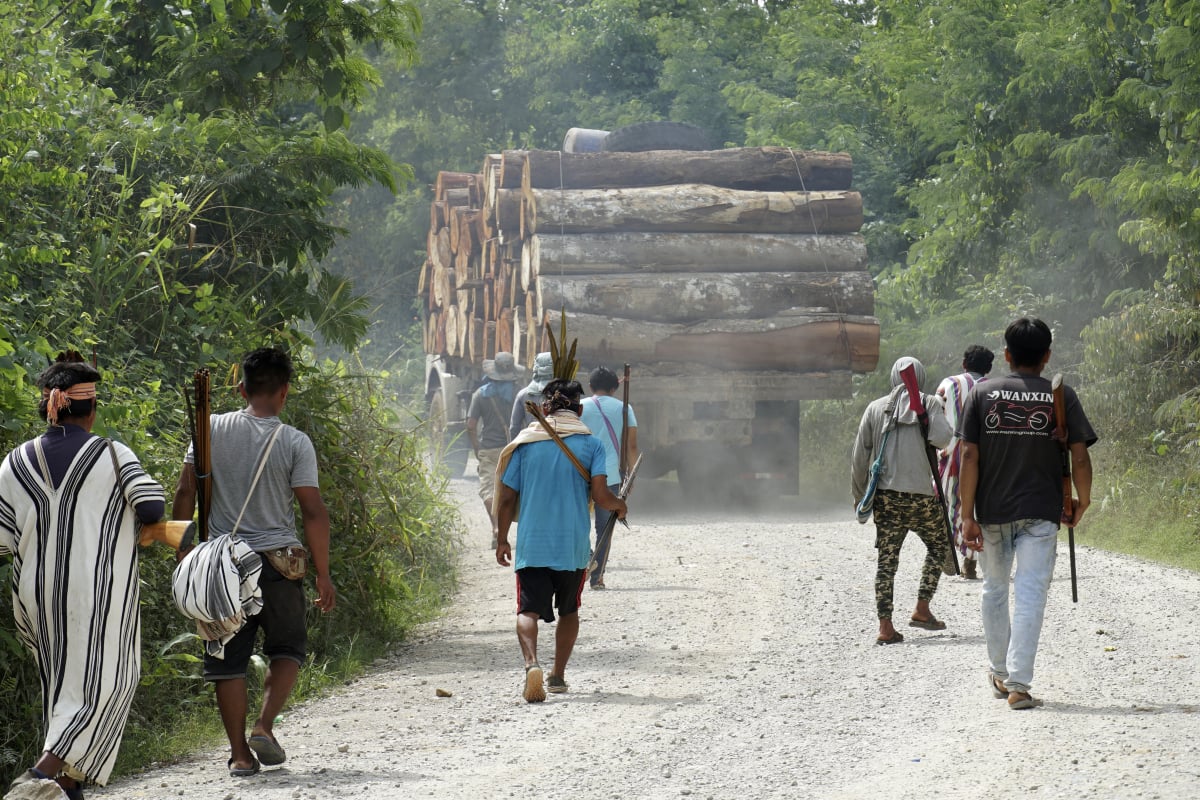Humanity needs a 'double movement' to stabilize our climate

Ashaninka Indigenous men, armed with shotguns, and bows and arrows, force a truck, transporting logs cut down in the Amazon forest, to turn back around, while blocking a road in protest over the murder of their 57-year-old Ashaninka leader Santiago Contoricon, in Puerto Ocopa, Peru, Saturday, April 15, 2023. Photo by: The Canadian Press/AP/Franklin Briceno)
As the leaves fall and the shirts turn flannel, climate advocates know it's time to ready themselves for the annual COP season — when the governments of the world gather for the UN treaty talks, called the Conference of the Parties. But this year will see an unusual cacophony of COPs.
Scattered in cities around the world, the last months of 2024 will have the usual COP about climate change in November as well as a separate one about desertification, in December. There’s also going to be a global negotiation to finalize a new treaty on plastic pollution (although that one’s not technically a “COP” since the treaty doesn’t exist yet, so there are no “Parties” to “Confer”). But first up, and before any of those other chinwags get underway, Colombia will host a biodiversity COP, starting Oct. 21.
You might remember the last “nature COP” because it was hosted by Canada and held in Montreal in 2022. It got more attention than usual because, among the four “goals” and 23 “targets,” one stood out for its specificity: the parties each agreed to protect 30 per cent of their land and marine areas by 2030.
Colloquially known as “30X30” the Montreal framework was intended to reinvigorate global efforts to protect nature. The world has never met any of its previous biodiversity targets. Nature, by contrast, has been working overtime. The Earth’s oceans and land have been taking in about half our emissions from burning fossil fuels. Scientists are worried that unrequited love may not be offered indefinitely.
Warnings have been going off for some time. The Amazon is teetering on the edge of losing its role as a carbon sink. Rainforest areas managed by Indigenous people are sequestering carbon but forests outside now appear to be a net source and Southeastern Amazonia is already emitting more carbon than it absorbs.
Canada’s managed forests passed the tipping point two decades ago, according to an analysis by Barry Saxifrage. “There is this feel-good myth in Canada that our massive forest is offsetting some of our massive fossil fuel emissions,” Saxifrage writes. “That might have been true decades ago under our old, stable climate. But we’ve so weakened our forest — through decades of business-as-usual industrial logging and fossil-fuelled climate shifts — that it has switched to hemorrhaging CO2 instead of absorbing it.”
While it will take some time to figure out what’s happening at the global level this year, the numbers for 2023 are not good. Worldwide, forests, plants and soils released almost as much carbon as they absorbed, according to an international team of sixteen researchers. There was a “large decline of the land carbon sink in 2023,” they write.
Not good at all. When nature spurns our fossil carbon, it gets added to that heat-trapping blanket in the sky. It’s important to recognize that the 2023 findings are for just one year. We are running this reckless global experiment for the first time and no one can predict how quickly the planet’s land sink will decline. But the broad trend is well-understood: the hotter the world, the weaker the land sink.
“Nature has so far balanced our abuse. This is coming to an end,” explained Johann Rockström, director of the Potsdam Institute for Climate Impact Research, at a New York Climate Week event in September.
When the world’s governments kick off the “Biodiversity COP” in Colombia on Oct. 21, they won’t only be facing nature’s carbon problems. Global wildlife populations have continued to plummet, despite the many declarations, goals and targets at the many COPs.
Wildlife populations have fallen by 73 per cent since 1970, on average. It’s an extremely difficult thing to measure but that’s the headline result from the best global survey anyone’s undertaken.
Every two years, WWF and the Zoological Society of London pull together a Living Planet Report — an index based on 34,836 wildlife populations that get studied enough to generate data. The latest edition was released last week ahead of the biodiversity COP. The population declines range from 95 per cent in Latin America and the Caribbean to 35 per cent in Europe. For North America, the estimate is that wildlife populations have shrunk 39 per cent, on average.
For those attuned to the plight of nature, declines in wildlife populations will not come as much of a surprise. You might have seen the recent reports that grassland bird populations have dropped 67 per cent in Canada over the last 50 years. In the forests of B.C., there is precisely one female spotted owl left in the wild. In Quebec, some herds of boreal caribou have crossed the “threshold of near-disappearance.” Even when the poor creatures have been so decimated, their habitat continues to be logged.
The Living Planet Index is often misunderstood. And the news is bad enough without overstating what it reveals. So, just to be clear, the report is not saying that 73 per cent of species have gone extinct or even that 73 per cent of species are in decline. Globally, about half the studied populations were found to be stable but half were in decline. Some are in very serious trouble and the average decline across studied populations was 73 per cent.
One heartening aspect of the biodiversity summit will be the host nation itself. Colombia is the first major fossil fuel producer to join the alliance calling for a fossil fuel non-proliferation treaty – a bold move for a developing country that is the sixth largest exporter of coal in the world.
Oil and coal account for half of Colombia’s exports. But President Gustavo Petro’s government has moved to end licenses for new oil and gas exploration and Colombia has become a vocal international advocate for a fossil fuel phase out.
“We are confronted with a struggle between fossil capital and human life, including the life of our planet,” Petro declared at the climate COP last year. “And we must choose a side.”
Since Petro was elected in 2022, deforestation in Colombia has dropped to the lowest level since record-keeping began, particularly in the country’s portion of the Amazon. Colombia’s environment minister, Susana Muhamad will oversee the biodiversity COP. In September, she launched a $40 billion investment plan with the goal of transitioning off fossil fuels and prioritizing biodiversity.
“There is a double movement humanity must make,” she says. “The first one is to decarbonise and have a just energy transition. The other side of the coin is to restore nature and allow nature to take again its power over planet Earth so that we can really stabilize the climate.”






Comments